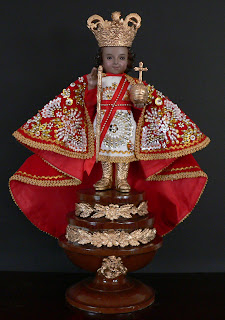The Santo Niño de Cebú ("Holy Child of Cebu") is a Roman Catholic figure of the Child Jesus highly similar to the Infant Jesus of Prague. Like the image's counterpart in Prague, the figure is clothed in expensive textile robes mostly donations from fervent devotees in the Philippines and abroad. The statue is the oldest Catholic relic in the Philippines and permanently housed since 1565 at the Basilica Minore del Santo Niño in Cebu City, Cebu.
In April 1521, Portuguese explorer Ferdinand Magellan, in the service of Charles I of Spain, arrived in Cebu during his voyage to find a westward route to the Indies [1]. He persuadedRajah Humabon and his wife Hara Amihan, to pledge their allegiance with Spain. They were later baptized into the Catholic faith, taking the Christian names Carlos and Juana. Magellan presented the Santo Niño to the newly-baptized Queen Juana as a symbol of the alliance. To her husband Carlos, Magellan presented the bust of the "Ecce Homo", or the depiction of Christ before Pontius Pilate. He gave an image of Our Lady to the natives who were later baptized with their rulers. However, Magellan died later on April 27, 1521 in the battle that took place in Mactan.
Many years later in 1565, Juan de Camus, a mariner of the second generation of Spanish Colonial campaign under Don Miguel Lopez de Legazpi found inside a pine box an unscathed Image of the Santo Niño. The adorable image believed to be of Belgian origin stands roughly at 30.48cm tall, wearing a loose velvet vestment, a gilded neck chain and a woolen red hood. It is carved from wood and coated with paint. The image holds a golden ball, a replica of the world in the left hand, and the right hand is slightly raised as a gesture of blessing.
FEAST
The Fiesta Señor celebration starts on the Thursday after the Solemnity of the Epiphany. Each year, the celebration starts with a procession called the Walk with Jesus and ends with the Walk with Mary, wherein the image of Nuestra Señora de Guadalupe de Cebu, in full regalia, is carried in procession on the streets of Cebu at dawn. On the last day of the novena, the images of Señor Santo Niño de Cebu, Nuestra Señora de Guadalupe de Cebu, and the Ecce Homo, is motorcaded to the National Shrine of Saint Joseph in Mandaue City for the traditional "traslacion", which means 'to transfer'. The images shall then be sent back to the Basilica on the eve of the feast of Señor Santo Niño de Cebu through a well-attended fluvial procession at Mactan Channel. Upon arrival at the Basilica, a high mass commemorating the first baptism shall take place. After which a long grand solemn foot procession, usually attended by more than a million devotees of the Santo Niño starts in a route that changes every year.
Pontifical masses, officiated mostly by Cebuano bishops are celebrated during the feast proper. The Holy See approved special liturgical texts for use during the local Feast of the Santo Niño in the Philippines, set on the third Sunday of January. The festival that follows is known as theSinulog, which combines the festivities and religious devotion of the Cebuano people.
THIS JANUARY 16, 2011!!!


